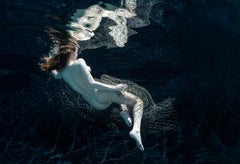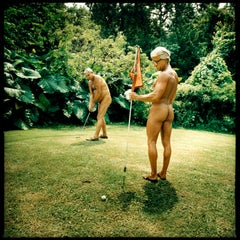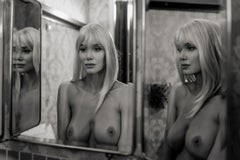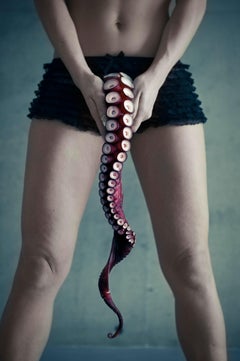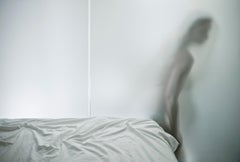Okurimono
Pigment Print
Images from the Okurimono series is available in 3 different formats :
* 50 x 75 cm : edition of 10 + (+2ap)
* 80 x 120 cm : edition of 7 + (+2ap)
* 113 x 170 cm : edition of 7 + (+2ap)
Each print is numbered and signed
About the work :
Work by contemporary photographer Christian Houge, from the Okurimono series.
In this series, Houge has, through five trips to Japan (Tokyo, Osaka and Kyoto), explored Japans otherworldly subculture and its ritualistic perfection. In this personal art documentary he has ventured into delicate themes such as personal identity, sexuality, longing and gender dysphoria. In this particular series, he uses staging as a method to create a story within a story. The viewers associations are important in meeting this work and ambiguity plays an important role.
In this series, Houge has, through five trips to Japan (Tokyo, Osaka and Kyoto), explored Japans otherworldly subculture and its ritualistic perfection. In this personal art documentary he has ventured into delicate themes such as personal identity, sexuality, longing and gender dysphoria. In this particular series, he uses staging as a method to create a story within a story. The viewers associations are important in meeting this work and ambiguity plays a
Okurimono (meaning both “gift” and “that which is in-between” in Japanese) - is a word that binds together this comprehensive project developed over five trips to Japan between 2007 and 2018.
The series explores the personal pursuit of identity, at times with an underlying darkness as Houge had the chance to be introduced to Tokyo’s subculture. In exploring this theme, Houge has ventured into delicate matters such as sexuality, longing and gender dysphoria. In this particular series, he uses staging as a method to create a story within a story.
The artist wishes to question the viewer and provoke a reflection on topics that are often seen as taboos in our contemporary societies. The viewer’s own associations are important in appreciating this work where ambiguity plays an important role.
The project started in the Harajuku district of Tokyo which is known as a center of Japanese youth culture and where Houge found some of his first motifs: teenage girls dressing up in post-Victorian dresses or ‘cosplay’ costumes to identify with a character of their favorite comics. Here, the desire to express one’s uniqueness is central and the photographer explores the tension between personal identity and aesthetics shared by all (or at least by the same youth group).
In many of his carefully staged photographs, Houge’s models are masked, so as to echo the many social masks we wear in our day-to-day lives. In our post-modern information society, drained of wonder, these enigmatic masked characters also evoke the world of shamans and pagan rituals, therefore injecting a sense of mystery and spirituality that many people are longing for.
Symbolism and the many references to ritual and identity in an otherwise suppressed society, may at times create a sense of unease among viewers. The Okurimono project also explores the topic of identity and sexuality in gender dysphoria with Japan’s nyūhāfu (the transsexual ‘new halfs’). Here, the quest for identity coincides with a search of femininity and body image which results in complex physical transformations. Viewers may look at these portraits not having any clue that models are nyūhāfu. Yet, the photographs are staged so that viewers are placed in a disconcerting voyeuristic role while looking at otherwise closed world.
Shibari (the art of tying), which originates from the Edo period (1600s), is another territory explored by Houge in his Okurimono series. His striking photographs of female models tied with red rope on a white background take us into this powerful journey into vulnerability and surrender, power and freedom.
Through tradition, symbolism and technology, Okurimono also explores the hugely potent symbols that help define parts of Japanese culture and national identity, between old and new. As Art historian Erling Bugge put it: “Christian Houge guides us into a mystery. It resides between the ritualized shapes of the traditional and withdrawn Zen garden in Kyoto and the equally ritualized spaces of futuristic, urban Tokyo. For a westerner, Japan might look familiar, since what is held up for us looks like a futuristic spectacle somehow grounded in a western imagination. This judgment, however, is too easy. In Houge’s photographs, the sense of sameness withdraws and a very different feeling of strangeness creeps up on us. In fact, what this series registers is a remarkable place of alterity in today’s global order, a radical difference bang in the middle of the familiar.”
The images of the Okurimono series share a ghostly, otherworldly quality. In reality and dream, ritual and play merge while the boundaries between the known and the unknown dissolve.
Christian Houge – Now – Okurimono
Christian Houge guides us into a mystery. It resides between the ritualized shapes of the traditional and withdrawn Zen garden in Kyoto and the equally ritualized spaces of futuristic, urban Tokyo. For a westerner, Japan might look familiar, since what is held up for us looks like a futuristic spectacle somehow grounded in a western imagination. This judgment, however, is too easy. In Houge’s photographs, the sense of sameness withdraws and a very different feeling of strangeness creeps up on us. In fact, what this series registers is a remarkable place of alterity in today’s global order, a radical difference bang in the middle of the familiar.
This is pushed to the limit in the technological and virtual wonderland of Akihabara in Tokyo, where shop after shop trade in electronic products and computer games, while a weird costume play, “cosplay”, is being performed in streets. A similar kind of simulation is being acted out in the district of Harajuku, where Houge found some of his motifs. There is no authenticity here, no western “essence” or “reality”; instead, the virtual conquers the carnal body in a purified play of surface, image and the hyperreal. This is exotic. All the while as we are conscious of these notions as pinnacle points in a western idea of the post-modern. But in this sense Japan has always been “post-modern”. It has always integrated the most refined culture and technology from the outside while somehow retained an identity for itself. So, what would this identity be? Houge takes the view of ritual and play. Indeed, Japanese culture seems to be grounded solely on ritual, in business and in sex, in its relation to nature and in religion.
This play transcends the notion of authenticity altogether, unlike the West which is haunted by the “ghost” of origin and beginnings. In Japan, “now” would mean just that; it is a “no looking back”, but rather a flow of intensities integrated in the play and ritual of the ever-present, okurimono. There is no threat of being eaten up by western culture and technology here, for, like in Zen practice, the ritual oversees everything and has no historical drag. Japan becomes weightless, shot into orbit outside the material of earth itself.
Is acting out the role as Lewis Caroll’s Victorian girl driven by a sense of nostalgia? I think not. It is a striving for a moment of perfected presence, in dialogue with Houge’s optical machine. It is the moment of Now. The girl, the Zen garden and the image shares in a perfection modified by small uncertainties, coincidental imperfections that become somewhat oblique points of entry for us - a discarded handkerchief or seemingly unremarkable shapes and reflections in the prismatic play of surfaces.
There is a ghostly, otherworldly quality in these images, even in the fleeting blossoming cherrytree and the play of shadows across a concrete minimalism. The doubly exposed or reflected light on the lens reminds us of the uncertain beginnings in photography’s history, with its widespread belief that the camera was able to perceive more than the naked eye, like spirits and ghosts. In Houge’s images there are different specters, skeletal, natural shapes on the one hand, the machine and the virtual on the other. Here, like some scene from the film Blade Runner, there is an uncanny confusion and mix between the human and non human.
Maybe the search for a perfect moment in the perpetual flow of things is a romantic or melancholic longing for transcendent wholeness, a drive that is harnessed in a rigorous attention to visual detail. This compulsive discipline might seem absurd to any western observer, while longing itself form a common ground and will ultimately be the basis in our meeting.
Erling Bugge
Bio:
Christian Houge (born in Oslo 1972)
Based in Oslo, Norway, I have been making photographs for over twenty years and new insights continue to open. By exploring the relation, and conflict, between Nature and culture, I get a better understanding about Mans` condition.
I am interested in the consequences of Humankinds progression and how science often is the result of our conquering of Nature, both on Earth and beyond.
Mans` ego, consumer society, the last remnants of pure Nature and identity are recurring elements in my work. I often juxtapose the visually aesthetic with an underlying uneasiness. This often emanates a cognitive dissonance in the viewer to invite deeper truths and personal references.
Looking at our actions and place in environment, which we are so dependent on, is a recurring theme in all my exploration and can use everything from digital cameras to large format and panoramic analog cameras for specific projects.
I have exhibited extensively in galleries and museums in my native country Norway, as well as the US, England, France and China.
The series `Death of a Mountain`(2016-2021) is nominated for the 2021 Leica Oskar Barnack Award, as well as receiving an arts grant from Norwegian Arts Council.
Most recently, my series `Residence of Impermanence` 2017-2019 has been exhibited at five museums and several galleries already (including a solo show at Fotografiska, Stockholm (2019), and Les Recontres d`Arles, Haugar Artmuseum, Preus Muaeum of Photography and 2019 (Galerie Omnius, Arles).
In 2021, this series received ten nominations for the Prix Pictet Award with the theme FIRE.
`Residence of Impermanence` is currently exhibited at the UCR: California Museum of Photography in Los Angeles with the exhibition `Facing Fire,` Art, Wildfire and The End of Nature in the New West.`
This exhibition explores the ever-worsening forest fires due to climate change.
In 2005, my series `Arctic Technology`, was shortlisted for the BMW Prize at Paris Photo (Scout Gallery, London). In 2015, my series `Paradise Lost`(containing three of my main environmental series) toured between three large museums in China.
My other environmental work has been nominated for the annual Prix Pictet Award twice, with my series, `Barentsburg` and `Shadow Within`, for both Earth and Power themes.
In 2005, my series `Arctic Technology` was shortlisted for the BMW Prize at Paris photo (through Scout Gallery, London).
My work has been shown in numerous museums, including a symposium at Johnson Museum, N.Y., was included in traveling exhibitions with WHATCOM (Museum of Washington) with the exhibition `Vanishing Ice`, as well as a two-year museum tour in China environmental issues with Three Shadows Photography Art Centre in Beijing and the Norwegian Embassy.
Publications/books include `Vanishing Ice`and `Altered Landscape` (Nevada Museum of Art), including purchased work for their collection at Center for Art and Environment.
Selected exhibitions CV:
Christian Houge (born in Oslo 1972) - Curriculum Vitae
2021
`As far as my Eye can Sea – The Expedition Exhibition`
Rev Ocean, Bomuldsfabrikken Kunsthall, Arendal
`Facing Fire`, Collaborative, UCR ARTS:California Museum of Photography
Continuation
`Death of a Mountain`/ In;Human Nature`, Buer Gallery, Oslo
2020
`Facing Fire`, Collaborative, UCR ARTS:California Museum of Photography
2019
`Metafysica`, `Residence of Impermanence`,collaborative, Haugar Kunstmuseum, Vestfold
`Residence of Impermanence`, Fotografiska Museum, Stockholm. Solo
`Helt Dyrisk` Residence of Impermanence`, collaborative, Preus Museum, Horten
`Residence of Impermanence`, Galleri Fineart, Oslo. Solo
2017
`Shadow Within/Rituals` Gulden Kunstverk, Drammen. Solo
Commission, MAAEMO restaurant. `In;Human Nature`
`Mirror,Mirror` Hosfelt Gallery, San.Fran. Collaborative w/Ed Ruscha, Adam Fuss, Liliana Porter
2016
`In;Human Nature`, TM51 Gallery, Oslo. Solo
Fotofever/ParisPhoto, Louvre, Paris
Cornette de Saint Cyr, Auction, Paris
2015
Three Shadows Photography Art Center, Beijing, China. `Paradise Lost` .
`Arctic Technology/Barentsburg`/ Shadow Within. Solo
Fotofever (ParisPhoto), Artistics Art Gallery, Paris. Collaborative
How Art Museum, Wenzhou, China. `Paradise Lost`
Arctic Technology/Barentsburg/Shadow Within. Solo
Redtory, Guangzhou, China. `Paradise Lost`
Arctic Technology/Barentsburg/Shadow Within. Solo
2014
Fineart Gallery, Oslo `Shadow Within` 2010-2013 / `Darkness Burns Bright` 2013/2014. Solo
Beyond Earth Art • (contemporary artists and the environment)
Johnson Museum of Art, New York. Shadow Within. Collaborative
(incl. Olafur Eliasson, Edward Burtynsky, Mathew Brandt, Yun-Fei Ji amongst others)
The El Paso Museum of Art, Texas. `Arctic Technology`. Collaborative
Glenbow Museum, Alberta. `Arctic Technology`. Collaborative
LIFF (Lofoten International Photofestival)
`Shadow Within` w/speaking. Solo
2013
Nominated for the Prix Pictet Award/ `Shadow Within`.
Hosfelt Gallery, San.Fran. USA. `Shadow Within`. Solo
Accompanied by Call of the Wild`( Joseph Beuys, Ed Ruscha, Patricia Piccinini and
Alan Rath...
